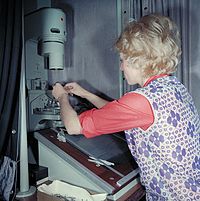
Photo from wikipedia
This study discusses the quality analysis of a new tapping machine. By measuring the torque and speed of the tapping machine, the correlation between the quality of the nut and… Click to show full abstract
This study discusses the quality analysis of a new tapping machine. By measuring the torque and speed of the tapping machine, the correlation between the quality of the nut and the tapping process is analyzed. Using various regression trees and learning methods, the results show that the magnitude of the tapping torque is an essential indicator of the quality of the thread. In addition, through such methods, the appropriate operation boundary of the tapper torque and tapper speed can be determined. Thread, processed in the two boundaries, can have a high probability of being a Class 1 thread. Furthermore, the tapping torque is also used for quality classification by a one-dimensional convolutional neural network (1-D CNN). The 1-D CNN model performs high classification accuracy and has the ability to localize the important area of the signal. The experimental results show that the regression tree can effectively find the operation boundary, providing information for users to adjust their machine settings, and improve the thread quality. In addition, the off-line classification of thread done by humans can be replaced by the high-accuracy 1-D CNN model predicting the thread quality in real-time. The detection speed can be accelerated, and labor costs can be reduced.
Journal Title: IEEE Transactions on Instrumentation and Measurement
Year Published: 2021
Link to full text (if available)
Share on Social Media: Sign Up to like & get
recommendations!